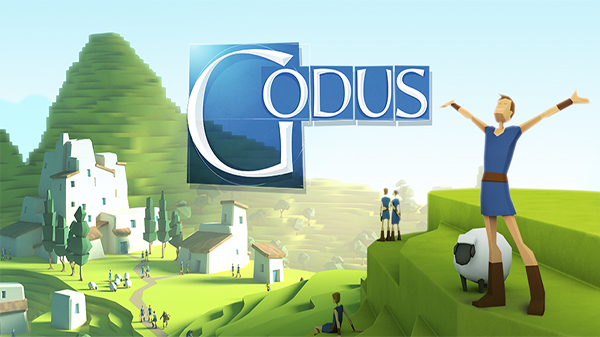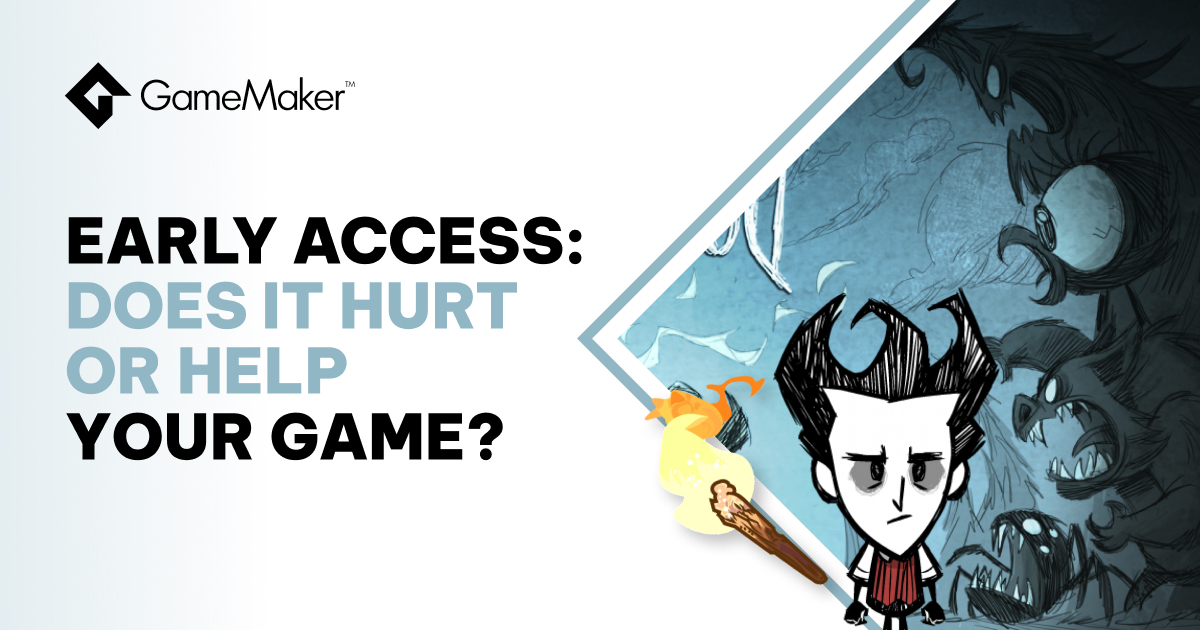When Steam announced their Early Access Program back in 2013, it sounded like a slam dunk: cheaper games and new experiences for players, real-time playtesters and additional resources for developers. No-one could lose, right?
Well, as popular as the program became with small to mid-tier indie developers, it soon became clear that Early Access games were a double-edged sword.
Some, like Don’t Starve and Valheim, benefited hugely from launching in Early Access. Others, like Infestation: Survivor Stories and StarForge, left a bitter aftertaste.
This article covers:
- What is an Early Access game?
- If you buy an Early Access game, do you get the full game?
- When do games enter Early Access?
- How long do games stay in Early Access?
- What was the first Early Access game?
- Are Early Access games still popular?
- Pros and cons of Early Access for developers
- Pros and cons of Early Access for players
- Alternatives to Early Access
- Best Early Access games in 2022

Don’t Starve, developed by Klei Entertainment
What is an Early Access game?
Think of Early Access as a pre-purchase for a game that isn’t finished yet.
The idea is that a developer makes an alpha or beta build of their game available to buy for a knock-down price.
For developers, it’s a chance to raise money to help with development costs, grow your community, and to canvas player feedback to help improve your game.
Players get instant access to the game and all future builds. They can also offer feedback to the development team to help shape the final version.
If you buy an Early Access game, do you get the full game?
You do - and you get a pretty sweet deal out of it, too.
Let’s say you pay $10 for an Early Access game that retails at $25 when the finished product launches. Not only have you saved yourself $15, you’ve also helped a small indie developer bring their vision to life.
When it all goes as smoothly as that, it’s a win for everyone involved.
(Spoiler: it doesn't always go as smoothly as that.)
Valheim, developed by Coffee Stain Studios
Can you refund Early Access games?
Steam allows you to refund any game if:
- You make your refund request within 48 hours of buying the game
- You’ve played the game for less than two hours
Steam’s return policy is particularly handy if you’ve bought into an Early Access game that turns out to be as fun as a carnivorous bacteria.
It poses an extra challenge for developers, though. You’ve got 120 minutes to prove to your players that they've backed the right horse, or you risk losing their support.
When do games enter Early Access?
Games should only be released to Early Access when they’re in a suitable condition to be seen by the paying public. As a developer, you need to be sure your game is worth paying for now, even if you know it will be in six months time.
Timing is absolutely critical here. The state in which you release a game to Early Access can make or break your game’s short-term and long-term success.
Take a game like The War Z. When it entered Early Access in 2012, players discovered that many of its advertised features simply weren’t in the game. The developers opted to calmly and rationally resolve the problem by perma-banning all players caught leaving negative reviews. As you do.
The game was later renamed to Infestation: Survivor Stories to distance it from previous scandals, but by then, the damage was done.

A review for Infestation: Survivor Stories when it released in Early Access
How long do games stay in Early Access?
Much like the temperature of a grizzly bear’s porridge, you need to get the answer to this question just right.
The only accurate answer is ‘as long as it needs to be’. If your game is stable, playable, and complete, you should think about releasing it as a finished product. If it’s still buggy and unfinished, it needs to stay where it is.
The difficulty is that the longer a game remains in Early Access, the more sceptical players become.
It’s important for developers to be honest about why their game remains in Early Access, publish regular updates, and keep the lines of communication open with their community.
Why do games stay in Early Access for so long?
Some of the factors that affect how long a game stays in Early Access include:
- The size of the development team. The space exploration game Rodina, for example, originally released in Early Access back in 2014. Even though it’s approaching a decade in Early Access, there’s only one guy working on it, so we can probably cut him some slack.
- The game’s genre. Simple, linear games like 2D platformers aren’t as complex to develop as open-world space simulators like Rodina. If a game like Super Mario Bros. was in Early Access for a decade, you’d get the feeling something wasn’t right.
- The game’s budget. Some developers rely on sales of Early Access games to continue funding its development. If the game doesn’t attract enough interest, the full release will inevitably get pushed back.
Rodina, developed by Elliptic Games
Are Early Access games still popular in 2023?
They are, but not as much as they used to be.
After nearly a decade on the Steam Store, Early Access games have been tainted by so many horror stories that trust in the program has dwindled.
For every Subnautica or Factorio - two giant success stories for Steam’s Early Access Program - there’s a StarForge or Spacebase DF-9, which were both abandoned by their developers without offering refunds to their playerbase.
Spacebase DF-9’s developers, Double Fine (yep, of Psychonauts and Grim Fandango fame), even made the game’s code open-source so the community could finish the project instead.
So basically, everyone that paid for Spacebase’s Early Access build bought coding homework.

A review for Spacebase DF-9, developed by Double Fine Productions
Pros and cons of Early Access for developers
|
Advantages |
Disadvantages |
|---|---|
Additional funding |
Oversaturation |
Player feedback |
Negative reviews |
Community growth |
Managing expectations |
Advantages
Additional funding
Making games can be expensive. Many indie devs release Early Access games to raise the capital they need to improve the existing build and complete development.
Player feedback
Playtesting is long work. Most AAA studios hire entire teams of playtesters to hunt down every single bug, glitch, or softlock in their games.
With Early Access games, the players become your playtesters, helping you identify problems and suggesting improvements that you may never have thought of.
Community growth
When Early Access games are done well, your players become your biggest advocates.
Sharing your journey with a passionate community is an endless source of inspiration, and you’ll have an army of players championing your game to support your marketing efforts.
Disadvantages
Oversaturation
At the time of writing, there are just over 7,000 Early Access games available on Steam, all competing for people’s attention.
The pool of gamers happy to support Early Access titles is thinner than it's ever been. With so many other games to compete with, you need to make sure your game is capable of standing out from the crowd.
Negative reviews
If you’re releasing an incomplete game, you need to prepare yourself for negative reviews. They won’t always feel fair, given Early Access games aren’t meant to be perfect, but not every buyer will understand what they’re getting into.
Negative reviews can leave a long-lasting stain on your game’s image, even if you go on to address the issues in later updates - especially if you get a substantial number of them.
Take a game like Craftopia: largely seen as one of the better Early Access games going today, a misunderstanding over whether the developers Pocketpair had abandoned the project to start work on a new title resulted in a wave of negative reviews.
As it turned out, what Pocketpair were announcing was a brand new project developed by a separate team, but by that point, the reviews were in and the damage was done.
Managing expectations
Yesterday, your game belonged to you and your development team. Today, it belongs to hundreds of strangers who get to suggest things and not worry about the work involved. Or at least that’s how it’ll feel some days.
Your community’s passion will be inspiring, but it also comes with a new responsibility: managing the expectations of hungry fans who had a taste, and now want to rest of the meal.
Always remember that most people are understanding members of society that realise that these things take time. And that Twitter has a mute button to help you deal with the ones that aren’t.

Craftopia, developed by Pocketpair
Pros and cons of Early Access for players
|
Advantages |
Disadvantages |
|---|---|
Discounted games |
No guarantees |
Sense of ownership |
Too early for Early Access |
Advantages
Discounted games
Everybody loves a bargain, and Early Access games are an absolute steal when they’re done well.
Subnautica entered Early Access at $18, before rising to $25 when it officially released in 2018, and again to $30 in 2021. Early adopters got a juicy discount, helped bring Subnautica into being, and got the satisfaction of knowing that they were there from the start.
Sense of ownership
Buying an Early Access game isn’t just a financial investment - it’s an emotional one, too. Sure, you could toss a few dollars in a developer’s tip jar or back a game’s crowdfund, but once you’ve parted with your money, you don’t always get something tangible to see and feel.
Having access to the latest builds of a game you’ve thrown your support behind is a special experience. You want this game to succeed as much as the developer does, and you’ll always feel a sense of responsibility for it.
Disadvantages
No guarantees
Abandonware - the industry term for games that are abandoned in the middle of development - is rife with Early Access titles. Sometimes, developers have legitimate reasons for abandoning their games. Others just walk off with your money and don’t stop to say goodbye.
There will always be an element of dice-rolling involved with Early Access. Even games like Godus, created by Fable developer and industry legend Peter Molyneux, became abandonware in 2016.
And if you can’t rely on the man who admitted to making up gameplay features to “stop journalists falling asleep”, who can you rely on?
Too early for Early Access
Early Access games aren’t meant to be perfect, but they shouldn’t get a free pass if they’re an absolute shower, either.
Too many developers make the mistake of releasing games to Early Access well before they should: a level of jank comes with the territory, but players have a right to expect something playable when they hand over their money.

Godus, developed by 22Cans
Alternatives to Early Access
If you like the idea of growing your community and getting some extra money in, but bridle at the thought of sharing your game with the public before it’s ready, there are a few alternatives you should consider.
Crowdfunding
Crowdfunds give you a little more control over your own narrative than Early Access releases.
People can still support you financially by backing your project, and your community can still grow as more people join your campaign, but giving them access to the current product is completely up to you.
Backers will rightly expect updates and some form of reward for supporting your crowdfund, but you can share gameplay updates in blogs, trailers, or videos, rather than let your players loose in an incomplete build.
Demos
Demos share a lot of similarities with Early Access games. The key difference is that demos are free, self-contained experiences.
With a demo, you can give players a taste of the final product in a controlled environment, without them watching your game go through its messy growing pains.
Demos are a popular method of generating interest in both indie games and AAA releases, such as Through the Nightmares and Kirby & The Forgotten Land.
Through the Nightmares, developed by Sandman Team
GX.games
Indie-friendly websites like GX.games allow you to release anything from full releases to simple proofs of concept to their platforms.As with demos, you’ll be sacrificing revenue, but what you’ll gain in honest feedback could prove vital to your game’s development.
GameMaker games can be exported to GX.games for free on any of our subscription tiers, too.
Best Early Access games in 2023
Some of the most encouraging games currently in Early Access include:
- Fraymakers - an indie crossover fighting game inspired by Nintendo’s Super Smash Bros. series. Fighters currently include Octodad, Welltaro from Downwell, and The Watcher from Slay The Spire.
- Timberborn - it’s like SimCity, but with beavers. Humanity has fallen, and it’s up to you to build a new society fit for nature’s engineers.
- Disney Dreamlight Valley - Animal Crossing meets Disney in this cosy little life sim. Craft, farm, and build your perfect village in the company of some of Disney’s most iconic characters.
- Against the Storm - Rebuild civilization and reclaim the wilderness in the face of apocalyptic rains.
- Phasmophobia - already a viral sensation, Phasmophobia tasks you with gathering evidence of paranormal activity in this psychological co-op horror.

A review for Timberborn, developed by Mechanistry
So, it’s time to decide: are Early Access games as bad as all that, or can they breathe new life into your game’s development?
Well, that depends.
For developers, the challenge lies in releasing a good product today that‘ll be even better tomorrow, managing your community, steadily implementing their feedback, and keeping the lines of communication open.
Releasing a game in Early Access is never a guarantee of success, but when they’re done well, they can change the course of your game forever.
If you’d like a little extra guidance on whether Early Access is for you, head over to the GameMaker Forum and put your questions to our indie dev community.
Happy GameMaking!


